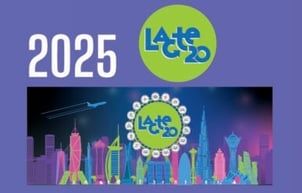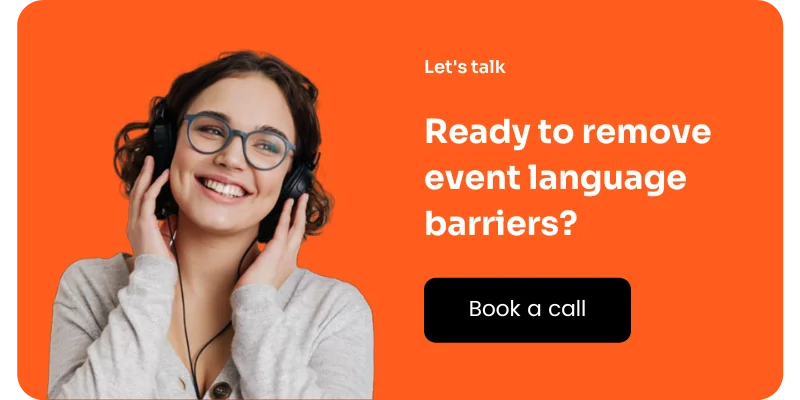The International Organization for Standarization (ISO) defines interpreting as "rendering of spoken or signed information from a source language to a target language in oral or signed form, conveying both the register and meaning of the source language content". Add "remote" to this definition and it then seems obvious that we are referring to the act of interpreting in the distance but, is there only one way of doing it? and, where is it used?
In this article we will cover:
- Who can use remote interpretation?
- What are the different delivery channels used for it?
- What are the different interpreting modes?
- What are some common use cases?
- What are the benefits of remote interpreting?
- How does it work?
- Can I combine on-site and remote interpreters for an event?
Who can use remote interpretation?
Remote interpreting can be used by anyone who needs to bridge a language gap and:
- has participants in different locations and/or
- has the interpreter at a different location to that where the event or meeting is taking place.
Traditionally, remote interpreting has been the means used by the deaf and hard of hearing to engage in telephone conversations (see video relay service below).
What are the different delivery channels used for remote interpreting?
Because participants are in different locations, remote interpretation has to be delivered differently than the traditional interpreting scenarios. These channels are mainly two:
- over the phone (OPI): over-the-phone interpretation is when the interpreter uses the phone to provide interpreting services.
- video interpreting: Here we can distinguish between video remote interpreting, where a web camera or videophone is used to provide sign language or spoken language interpreting services, and video relay service (VRS), a service provided to deaf people whereby a deaf person can contact the service and use the interpreter to contact a third-party organisation.
What are the different interpreting modes in remote interpreting?
Depending on the channel and type of meeting, interpreters can provide consecutive interpretation or simultaneous interpretation remotely.
- Consecutive interpretation - the interpreter waits for the speaker to finish talking to convey the message in the other language. This is typically the case in over-the-phone interpretation.
- Simultaneous interpretation - the interpreter renders the message in the target language at the same time that the speaker is talking. For this mode of interpretation to be delivered remotely, specialised platforms are usually required. These platforms allow interpreters to listen to the source message and deliver it in the target language in real-time while the audience can choose what language to listen to from the platform. This is called remote simultaneous interpretation.
What are some common use cases?
Remote interpreting, primarily in the consecutive mode, has been widely used in public service interpreting settings such as:
- Courts
- Police stations
- Hospitals
- Schools
- Emergency settings
In recent years, with the appearance of remote simultaneous interpretation software platforms like Interprefy, many companies and organizations have turned to use this form of interpreting for:
- Business meetings
- Conferences
- Governmental sessions
- Press conferences
- Hybrid events
- Webinars
- Panel discussions
- Training and townhalls
- Live streaming events
These setups usually opt for the simultaneous interpretation mode as it results in a shorter and more dynamic meeting than with the consecutive interpreting mode.
What are its benefits?
Before considering what the benefits of remote interpretation are, it is necessary to look at what are the advantages of adding interpretation to any of the scenarios mentioned above:
- Understanding each other - thanks to interpretation any multilingual scenario can go ahead without language barriers and misunderstandings.
- Accessibility and inclusivity - Allowing interpretation in your meeting or event opens the door to people that speak different languages and who might have hearing, physical, and vision impairments.
- Improve engagement - people attending a meeting with interpretation are able to follow the conversation and contribute in their own language, which increases their engagement.
- Increase your global reach - as you open the door to more languages you are opening the door to more opportunities, views, and talents.
When it comes to remote interpreting, it poses advantages to both the meeting organisers and interpreters.
Meeting organisers who choose to use RSI will benefit from:
- More floor space - because interpreters will work remotely, there's no need to install cumbersome equipment like interpreting booths, which will free up considerable space in your venue.
- Reduced costs - you'll be able to skip flying and accommodating interpreters as well as installing expensive interpreting equipment on-site.
- Greater versatility - if you work with the right RSI provider, interpretation can be delivered anywhere. Your audience can be on-site, online, or both. At Interprefy we integrate with over 60 online meeting platforms and have even delivered interpretation from the International Space Station.
- More interpreters to choose from - you'll no longer be tight to interpreters available locally or nearby. You can now choose the best-suited interpreters in your language combinations and meeting topic from all around the world.
- More languages to choose from - because the costs for RSI are lower than traditional on-site interpretation, you can offer more languages to your attendees. Similarly, because interpreters can work from anywhere, you'll have access to rare language combinations.
- Reduced event carbon footprint - removing the need for interpreters to travel will reduce the carbon footprint of your multilingual meeting or event.
Interpreters working on RSI assignments also enjoy benefits such as:
- Improved work-life balance - being able to work from wherever they want and removing the need to travel, interpreters now have more time to spend with their loved ones.
- New interpreting opportunities - because jobs are done remotely, interpreters can now access more job offers and even more learning opportunities based on their language combinations and not on their location.
How does remote simultaneous interpreting work?
Remote simultaneous interpretation, or RSI, works through a remote simultaneous interpretation platform. The interpreter's speech is transmitted to a cloud-based remote simultaneous interpretation platform through their laptop or desktop computer. The audience then connects to this RSI platform via a computer or mobile device and can see and hear the speaker in the language of their choice.
To learn everything about RSI you can access our Remote Simultaneous Interpretation Guide here.
Can I combine on-site and remote interpreters for an event?
Definitely! The RSI technology developed by Interprefy allows you to combine on-site and off-site interpreters for your meetings and events. How? Watch the video below to learn more.
Conclusion
Remote interpreting offers many benefits and comes in different modes. In its simultaneous mode, remote interpreting has become a growing part of multilingual events and meeting planning that increases accessibility and engagement.
Do you have an upcoming meeting or event with a multilingual audience and want to learn more about RSI, contact us below to see how we can help.


-min.png?width=1040&height=800&name=Blog%20Header%20(30)-min.png)


 More download links
More download links



